There’s a satisfying symmetry to the way Audrey Whitty appears to have stepped from the National Museum of Ireland, where she was deputy director, to the identical-looking home next door, on Kildare Street in Dublin, of the National Library of Ireland.
The truth is less neat. For a start, it’s a very significant step to become the library’s director, as Whitty did in February. And in any case the museum’s HQ is now at its decorative-arts branch, at Collins Barracks, rather than in the building next to the National Library, which has become its archaeology branch, so she wasn’t really next door.
But that whole block in the middle of Dublin has enormous historical significance in the story of who we are. Leinster House, which now houses the Oireachtas, was originally the home of the Royal Dublin Society – and, for the first 13 years of its life, of the National Library, which moved into its current building in 1890.
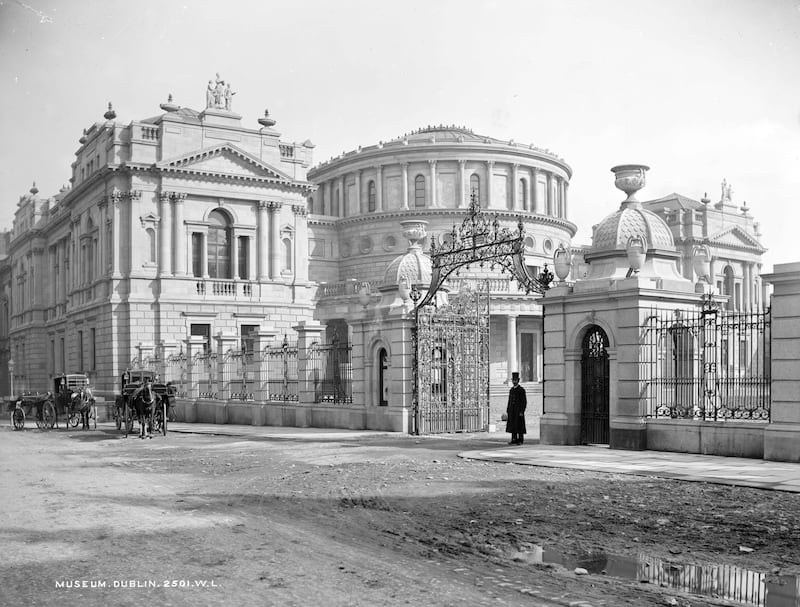
The architects Thomas Newenham Deane and his son Thomas Manly Deane designed the library and museum buildings to mirror each other (across a lawn that is now an Oireachtas car park). On the other side of Leinster House are the National Gallery of Ireland and the museum’s natural-history branch. The Royal Irish Academy is a hop-skip away. Quite the hub of civic life.
RM Block
On June 1st, Dr Whitty will lead the first of her monthly guided tours of the library, to “showcase our beautiful building, introduce our national collections and meet visitors face to face”. The tours underline for Whitty the way that the library’s “tradition of welcome, engagement and access underpins everything we do”.
As we stand in the glorious entrance hall – we’re here for a sneak preview of the tours she’ll be giving – Whitty glows with passion about the building, its collection of 12 million objects, and its significance for Ireland. We’re standing on a mosaic floor, made by Ludwig Oppenheimer of Manchester, whose design incorporates the word “Sapientia” – Latin for wisdom – and some owls, to symbolise that quality. Whitty points out the 12 beautiful stained-glass windows (by Jones & Willis of Birmingham) ringed around the rotunda, a very Victorian take on the greatest figures in world literature and philosophy: Dante, Goethe, Virgil, Chaucer, Shakespeare. There’s only one Irish writer, Thomas Moore (and, of course, no women).
Just off the main hall is the wood-panelled former director’s office, which now connects the original building to more recent additions, including its WB Yeats exhibition. The magnificent wooden fireplace is by Carlo Cambi of Siena.
These buildings were originally heated by fires, “a terrifying prospect in a library. It’s no wonder the librarian’s last duties were to tour the building with the housekeeper and ensure the fires were damped down,” Whitty says.
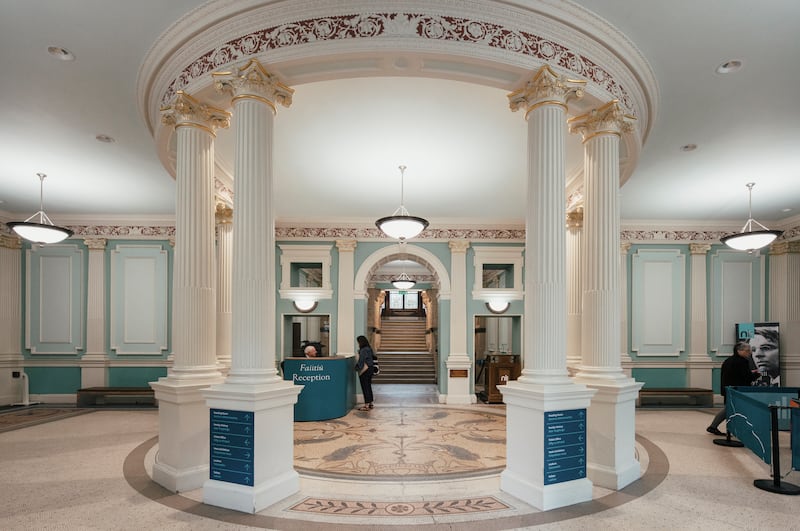
As we climb the sweeping staircase she points out the stone depiction of four continents, which is “obviously an important theme for libraries and museums” right now, in terms of the “decolonisation of collections and of what cultural heritage has traditionally stood for, looking at things with fresh eyes from the perspective of the communities that produced them”.
Facing us midway up are two more stained-glass windows, of Leonardo and, as his name is rendered here, Michel Angelo. On the landing is a plaque for Thomas William Lyster, the library’s director from 1895 to 1920, who was the model for Joyce’s “Quaker librarian” in Ulysses.
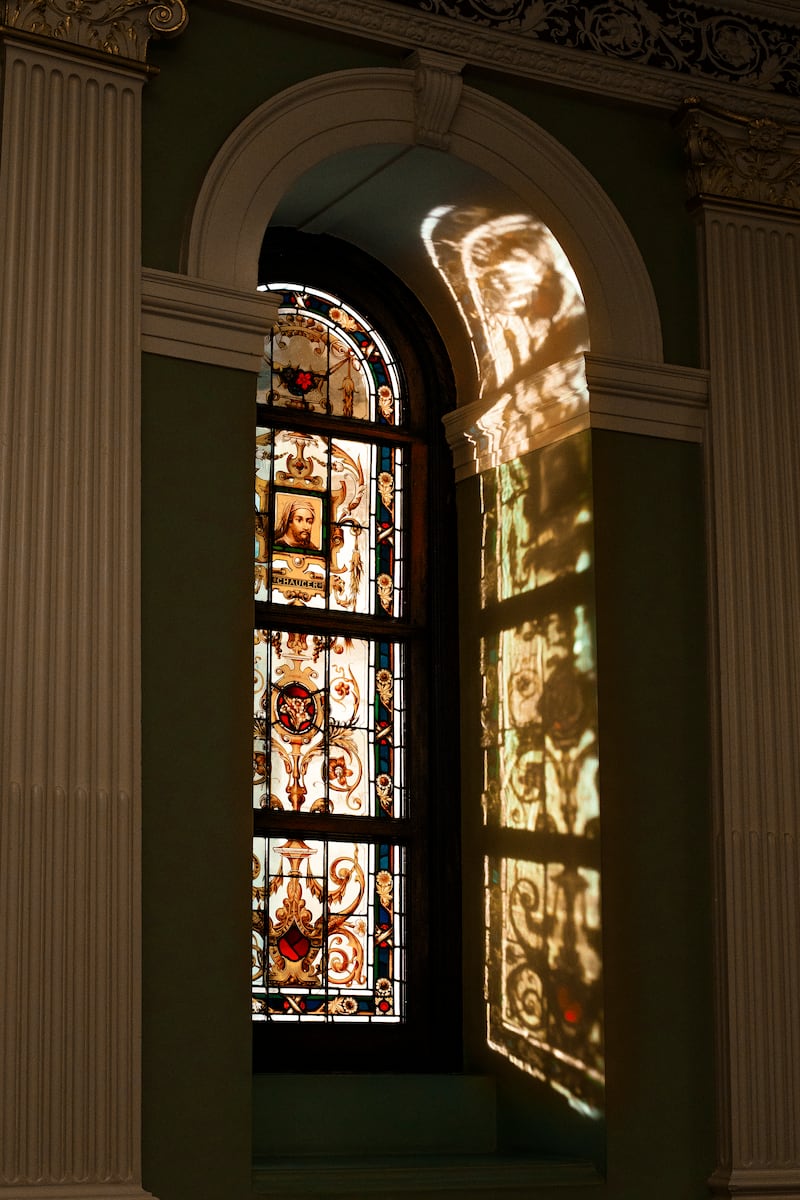
And then we walk into the magnificent main reading room, a stunning D-shaped rotunda with fine oak woodwork, its dome reminiscent of that of the British Museum in London, with light flooding in from above. “You are following in the footsteps of James Joyce and William Butler Yeats and millions of artists, poets, lawyers, historians, students and family-history researchers who have worked and learned in this room,” Whitty says.
The same Dobbyn & Son clock ticks, but the desks were introduced only in the 1920s and 1930s; the originals were bigger, and shared, but then abandoned because – shh! – they encouraged talking.
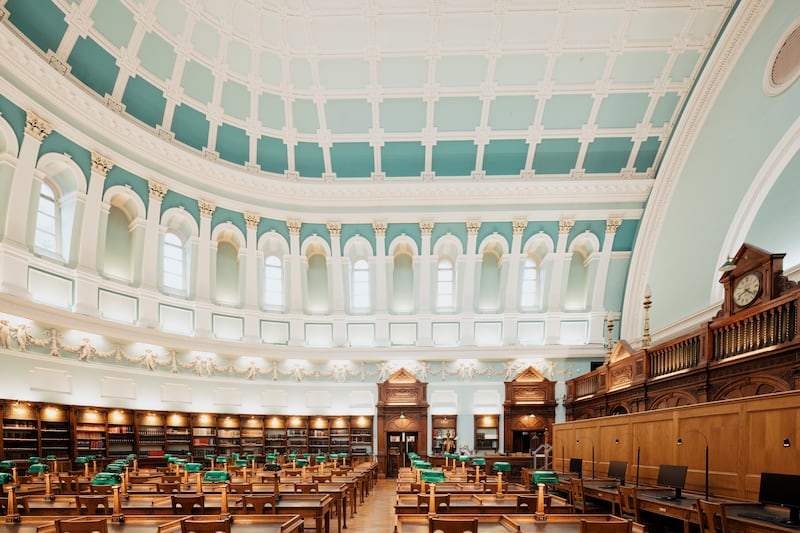
Dublin was poorly served by public libraries before the National Library opened. It was soon always full. There were complaints that the youth of 1890 showed a sad decline from the paragons of the 1860s, Whitty says – young people would sit and chat on the steps outside, cluttering up the place and bringing down the tone. Lyster’s response – “Oh, but they must be allowed to sit there, because this is their library” – is still very much the institution’s approach.
“Seamus Heaney, WB Yeats. James Joyce wrote the greatest novel of the 20th century. What countries have that kind of cultural capital?” Whitty says. “I do think the National Library is exceptional because of that. We’re so fortunate to have the major holdings of Yeats’s material, his actual library, his Nobel medal with its citation, all the original archives and documents. We are the main repository in the world for that, along with James Joyce, and also Seamus Heaney’s incredible donation to the National Library, from 2011.
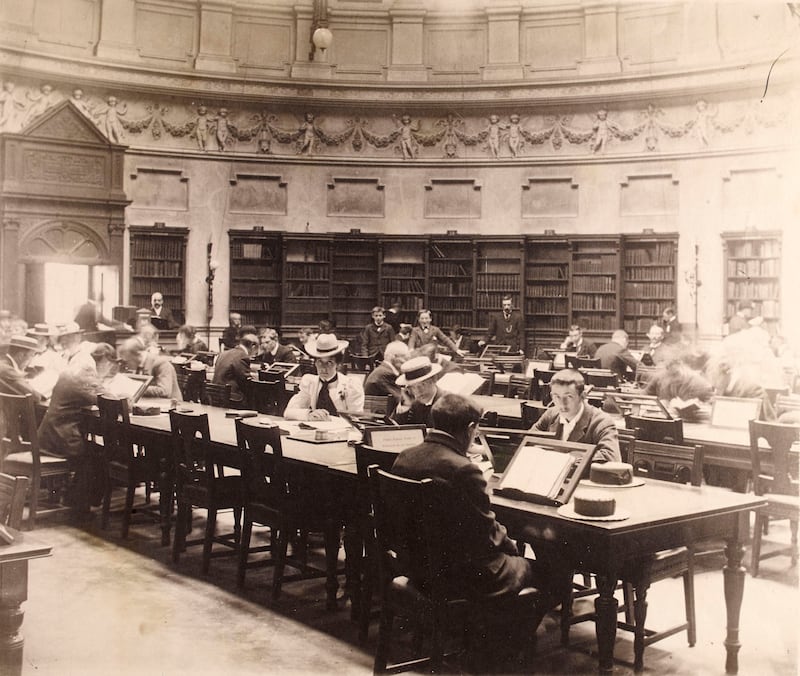
“It’s just astounding that a country this size has those incredible literary figures. I’m not just talking about the men. Female Irish writers, particularly since the mid-20th century, have been astounding in terms of the quality of their work: Edna O’Brien, Kate O’Brien, Maria Edgeworth. We have the digital archive of Marian Keyes. Then you look at contemporary writing, people like Doireann Ní Ghríofa, Kerri ní Dochartaigh, Claire Keegan.”
The Heaney material, which has been on show since 2018 as the library’s Listen Now Again exhibition, at the nearby Bank of Ireland Cultural & Heritage Centre, is due to move to Kildare Street in four years’ time, for the library’s 150th anniversary, after “the largest reconfiguration and development on this site since the building opened in 1890″.
Its new galleries, in space freed up by the transfer of some 350,000 volumes, will also include the Yeats exhibition, the library’s Live Aid-Band Aid archive, and displays about O’Brien and Edgeworth. There’ll also be learning and seminar spaces “where people can see their national library as a place to hang out and interact”, plus a shop and a cafe. It will be “absolutely revolutionary” in terms of research and accessibility, Whitty says, and the “exhibitions alongside the core offering we’ve always had – it will be unbelievably important for the country.”
The library’s holdings are vast. “We have an incredible music collection,” for example, Whitty says, “with material all the way back to the 17th century”, plus some of the earliest manuscripts in Irish. “Where the Book of Kells and the Book of Durrow, down the road in Trinity, leave off, the manuscripts collection of the National Library of Ireland takes off, particularly from the early 1000s onwards.”
The public can access the library’s 12 million holdings, digitally or physically, in the main reading room, the manuscripts room or the National Photographic Archive, in Temple Bar. “You order it in, go online, get your reader’s ticket and put in your request for what you’d like to see,” Whitty says. “It’s such an incredible place. There’s nothing like a national library. And there is only one in every country.”
Before leaving, I add a solo section to the tour, to use probably the most beautiful Victorian public lavatory in Dublin, in the library’s basement. Significant in the city when there were few female public toilets, the women’s bathroom is still spacious, comfortable and elegant. (The men’s is reputedly excellent, too.) A classy place all round.
Audrey Whitty’s first director’s tour is on Thursday, June 1st, 6-7pm. The tour, which is free, leaves from the library’s front hall; no booking is required. The next in the series will be on Thursday, July 13th, Thursday, September 14th and Thursday, October 12th




















